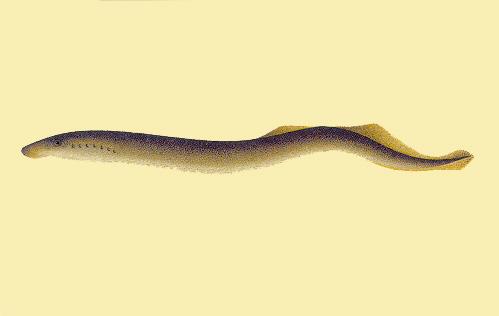Pacific Lamprey (Arctic)

A Pacific lamprey is widespread all over the basin of the White Sea, but on its Karelian territory and along the western coast lamprey is scanty. The greatest spreading this lamprey species has got on the territories of the region which border upon large inflows, - Onega, Mezeni, Severnaya Dvina.
In Karelia this species is likely to be seen in the largest of Belomorskiy rivers – Kemi and Viga. It reaches 50 cm lengthwise and 150 gm in weight.
It gets to rivers beginning from autumn (September), and reproduction is only next year in May-June. It can go up-stream for a long distance, up to 400 km and more.
Lamprey grown-ups are predators. Sticking to fish, they feed with their blood, gnaw out muscle tissues and sometimes even internal organs.
There is no special trade for this kind of lamprey in Karelia. That is because of its small quantity, and as a food it is very little attractive to people. However, in neighboring Arhangelsk region the lamprey is well caught, and during some years its catches run up to several tens of tones.
River Lamprey (Arctic)
The river lamprey is a little bit smaller than the Pacific one. Its length doesn’t usually exceed 30 cm. In Karelia this species is represented by a specific lacustrine kind that dwells in the basins of the lakes Ladoga and Onego. On the whole, this lamprey is an inhabitant of coastal seawaters and gets into rivers only during a spawning period. It is very widespread in Western Europe – from Italy to northern Norway. In USSR (the Baltic States and Leningradskiy region) it gets into rivers out of the Baltic Sea.
The lamprey gets into Karelian rivers only in autumn, during October – November.
Its larvae, also called “sandy diggers” and wrongly “loaches”, stay in rivers for 4-5 years, feed with detritus, small bottom invertebrates and diatoms plants, burring themselves into sand or silt.
Stream Lamprey (Arctic)
Stream lamprey is the smallest among the species of this type. Its length doesn’t usually exceed 15 cm. The whole life it spends in small rivers and streams, including those, where it goes up for spawning. It’s interesting that larvae of the stream lamprey are noticeably larger than grown-ups. It is bound up with the features of the stream lamprey’s biology: it feeds only during a larval stage and with finishing of transformation into a grow-up its feeding stops and a body shortens.
This lamprey is widespread almost all over in Karelia; especially it is numerous in rivers of the basin of Onego. As other species of lamprey, the stream lamprey is not for trade.
It is the only a non-predator kind of lampreys in our waters. That is because it doesn’t feed at all being a grown-up, and its larvae prefer vegetative heels, reached from silt.
